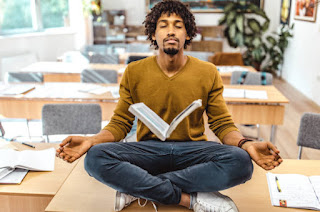Yoga for Students: Cultivating Focus and Mental Clarity in a Distracted World
Staying Grounded: Yoga for Students to Build Focus and Mental Clarity
In today’s hyper-connected world, students face unprecedented challenges when it comes to maintaining focus and mental clarity. With the constant buzz of notifications, a fast-paced lifestyle, and the pressure to succeed academically, it’s no surprise that stress and distractions have become common struggles. Yoga offers a practical solution to these challenges, helping students of all ages cultivate focus, boost concentration, and find a sense of balance amidst the chaos. Through specific yoga sequences, mindful breathing techniques, and daily routines, students can harness the power of yoga to thrive both in and out of the classroom.
Understanding the Challenges Students Face
For many young people, the pressures of school, relationships, and future planning can be overwhelming. Between juggling assignments, extracurricular activities, part-time jobs, and social obligations, time management becomes a crucial yet challenging skill. The constant exposure to social media and digital devices only adds to this pressure, often resulting in fragmented attention spans and an inability to focus on the present moment.
- Scheduling and Time Stress: Many students struggle with finding time for themselves amidst a packed schedule. This lack of downtime can lead to burnout and decreased motivation. Yoga offers an opportunity for even a few minutes of daily self-care, helping to recharge and regain focus.
- Social Pressures and Connection: Building meaningful relationships can be difficult in a world where connections often feel more virtual than real. Yoga and meditation help students become more present in their interactions, fostering deeper, more genuine connections with others.
- Avoiding Substance Reliance: With the rise of social media and digital culture, young people are frequently exposed to environments where substances like alcohol and drugs are normalized as a way to have fun or relieve stress. Yoga and mindfulness present healthier ways to cope with social anxieties and emotional stressors, offering a natural and sustainable path to well-being.
- Effective Study Habits: Concentration is key to academic success, but distractions can make studying feel like an uphill battle. By practicing yoga and mindfulness, students can train their minds to focus more effectively, making their study time more productive and less stressful.
Yoga Sequences to Improve Focus and Concentration
Specific yoga poses and sequences are designed to help quiet the mind, enhance concentration, and bring a sense of mental clarity. Here are a few recommended yoga poses that are particularly beneficial for students:
- Tree Pose (Vrksasana):
- How It Helps: Tree Pose requires balance and focus, helping to center the mind. It encourages students to concentrate on their alignment and breath, making it an ideal practice before a study session.
- How to Practice: Stand with feet hip-width apart, shift your weight onto one leg, and bring the sole of the opposite foot to rest on your inner thigh or calf. Press your palms together at your heart, focusing your gaze on a fixed point ahead.
- Eagle Pose (Garudasana):
- How It Helps: Eagle Pose requires both physical and mental balance, helping to improve focus and release tension in the shoulders and back—common areas of stress for students.
- How to Practice: Cross one arm under the other and wrap your legs in the same manner, bending the standing leg slightly. Focus on keeping your gaze steady and breathing evenly.
- Child’s Pose (Balasana):
- How It Helps: Child’s Pose encourages relaxation and a moment of inward reflection, making it perfect for taking a break between study sessions or when feeling overwhelmed.
- How to Practice: Kneel on the floor, touch your big toes together, and sit back on your heels. Fold forward, extending your arms in front of you and resting your forehead on the mat.
These poses can be practiced individually or as part of a short sequence to calm the mind and prepare for a productive day of learning. By incorporating them into a daily routine, students can build a foundation of focus and resilience.
Breathing Techniques for Better Studying
In addition to physical poses, breathing techniques, or pranayama, are powerful tools that can help students clear their minds and improve their focus. Here are a few breathing exercises tailored for concentration:
- Alternate Nostril Breathing (Nadi Shodhana):
- How It Helps: This breathing technique balances the brain’s hemispheres, helping to reduce anxiety and enhance focus. It’s particularly helpful before tests or during study breaks.
- How to Practice: Close your right nostril with your thumb and inhale through the left nostril. Close the left nostril with your ring finger and exhale through the right. Repeat for 5-10 minutes.
- 4-7-8 Breathing Technique:
- How It Helps: This technique slows the heart rate and calms the mind, making it easier to settle into a focused state.
- How to Practice: Inhale through your nose for a count of 4, hold the breath for a count of 7, and exhale through your mouth for a count of 8. Repeat for 3-5 cycles.
These simple exercises can be done anywhere, making them perfect for busy students who need a quick mental reset during a hectic day.
Integrating Mindfulness into Study Routines
Mindfulness doesn’t have to be a separate activity—students can integrate it into their study routines to make learning more effective and enjoyable. Here’s how:
- Mindful Breaks: Encourage taking short, mindful breaks between study sessions. During these breaks, students can stretch, breathe deeply, or simply observe their surroundings without judgment.
- Single-Task Focus: Instead of multitasking, focus on one assignment or task at a time. Set a timer for 25-30 minutes (a method known as the Pomodoro technique), and give full attention to the task at hand.
- Gratitude Journaling: Keeping a journal of things you’re grateful for can shift focus away from stress and help cultivate a positive mindset. This practice can be especially helpful before bed, allowing students to end the day on a positive note.
For more on building mental resilience and coping with stress, see my article Building Emotional Resilience: How Yoga Helps You Bounce Back, which provides insights into how yoga can help manage emotional challenges.
Free Resources for Students
In addition to yoga and meditation, a variety of free resources are available to support students in their academic and personal growth. Here are a few recommendations:
- Khan Academy: Offers free online courses across various subjects, allowing students to study at their own pace.
- Coursera Free Courses: Provides access to university-level courses on topics ranging from mindfulness to time management.
- Headspace for Students: Many meditation apps, like Headspace, offer free or discounted memberships for students, providing access to guided meditations tailored for relaxation and focus.
- Quizlet: A popular tool for creating digital flashcards and study aids that can make memorizing facts more efficient.
- YouTube Yoga Channels: Channels like Yoga with Adriene offer free yoga classes, including routines specifically designed to relieve stress and improve focus.
These resources empower students to take charge of their well-being without financial burden, promoting a balanced and healthy approach to student life.
Coping Beyond Meditation: Alternative Self-Help Techniques
While meditation is a powerful tool, it’s not the only way students can support their mental and emotional well-being. Here are some additional coping mechanisms:
- Progressive Muscle Relaxation (PMR): A technique that involves tensing and relaxing muscle groups to reduce physical tension. This can be especially useful before bed to ease into a restful sleep.
- Journaling for Reflection: Keeping a journal can help process emotions and track progress over time. Writing down thoughts can provide clarity during stressful periods.
- Creative Outlets: Engaging in low-cost creative activities like drawing, writing poetry, or playing music can be a healthy way to express emotions and take a mental break.
- Outdoor Walks: Spending time in nature has been shown to improve mood and concentration. A simple walk in the park can work wonders for clearing the mind.
Encouraging students to explore these methods can help them develop a toolkit of healthy coping strategies, fostering resilience and self-awareness.
Embracing a Balanced Student Life
Yoga, meditation, and mindfulness offer practical ways for students to build focus, improve mental clarity, and cope with the unique challenges of modern life. By incorporating these practices into their daily routines, young people can learn to navigate stress, build meaningful connections, and approach their studies with renewed energy and concentration. Beyond the mat, these techniques also support a balanced lifestyle, helping students enjoy life’s moments without relying on external pressures.
With a little dedication, students can find peace amidst the chaos, empowering themselves to face each day with focus, clarity, and confidence.









![Top Classes in Mindfulness Online – Updated [May 2024]](https://harmonycentered.com/wp-content/uploads/2024/05/IMG_2574-1.jpeg)
